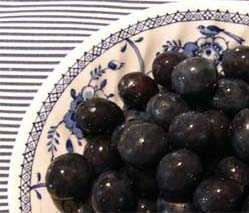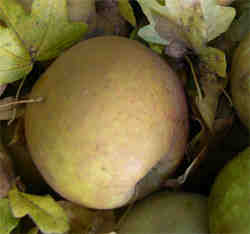Damson Cheese Recipe: for savoury and sweet dishes. How to freeze damsons/plums.
Posted by Fiona Nevile in Jam Jelly and Preserves | 65 comments
A dish of ripe damsons
At this time of year, we are given a lot of fruit for preserves. Quite often we pop them in the freezer (how to freeze damsons? See tricks and tips below) until we have time to turn it into something delicious. This morning we decided to make damson cheese.
Damson cheese is not cheese as we know it, Jim. It’s sweet, full of flavour and so dense with fruit that it is sliced, just like cheese. It’s tasty and just that bit more unusual than jelly. I do regret the occasion when my mum gave me a jar ten years ago; I didn’t even taste it before it died a furry death in my fridge. Now I know better.
Traditionally, damson cheese is sliced and served with lamb or game. We eat it with cheese and quite often have it as a pud with a dollop of cream. A slice on an individual plate of hors d’oeuvres looks classy.
Damson cheese is well worth adding to your repertoire.
If you are going to make damson cheese, make sure that you have some straight sided glass jars, or earthenware pots to pour it into so that you can easily slide it out for slicing. (Why not plastic? See tips and tricks below).
Recipe for our excellent damson cheese:
Ingredients:
- 2lbs/917gms of damsons
- 1/4pt/150ml of water
- White granulated sugar (1lb to each 1pint of damson puree)
- A squeeze of lemon juice( approximately 1/2 tsp)
Method:
- Wash, pick over and discard bad fruit.
- Put damsons and water in a large heavy bottomed saucepan. Bring gently to simmering point and simmer very gently until all fruit is soft and falling of the stones (this can take at least an hour or more). Keep an eye on it, stirring from time to time.
- When fruit is very soft, remove from the heat and cool before straining and pressing through a medium sieve. Discard the stones.
- Pour fruit into a measuring jug, note the quantity and return to the cleaned pan with the sugar and lemon juice.
- Stir over a gentle heat stir until sugar is dissolved.
- Bring to the boil and continue to boil briskly. Stir constantly, to stop the sugar burning on the base of the saucepan. Don’t skip this bit.
- The damson cheese it ready when the spoon makes a clear track mark on the bottom of the pan. Not a parting of the seas but but a glimpse of the bottom.
- Ladle into warmed, sterilised straight sided jars. (How do I sterilise jars and lids? See tricks and tips below).
- Allow to cool a little, whilst still warm, and cover with sterilised plastic lined screw topped lids or waxed disks and cellophane covers.
- Label when cold and store in a cool, dark, dry area. It should keep for a year.
- Once opened, keep in the fridge and eat within a month or so.
Tips and tricks:
How to freeze damsons (also how to freeze plums, blackberries, greengages, wild damsons and sloes):
- Pick over fruit and discard any bad fruit
- Wash fruit and dry in a large clean tea cloth
- Put fruit into labelled bags and freeze
Why can’t I use plastic (i.e. ice cream cartons, to store damson cheese in my fridge?
- A friend, who is a great chef, made a batch of damson cheese purely for personal consumption. The damson cheese was poured into a large clean, sterilised ice cream carton. Every now and then, a sizeable nugget of damson cheese was savoured. After a few months (once opened damson cheese keeps for ages in the fridge) the plastic tainted the damson cheese and the private cache had to be thrown out. Glass and earthenware are fine for damson cheese. After opening, store in the fridge.
How do I sterilise jars and lids?
- Sterilising the jars and lids:
We collect jars all year round for our jelly, chutney and jam making sessions. I try to soak off labels and store the clean jars and metal plastic coated screw-top lids in an accessible place. The sterilising method that we used is simple. Just before making the ‘cheese’, I quickly wash and rinse the jars and place them upside down in a cold oven. Set the temperature to 160c/140c for fan assisted. When the oven has reached the right temperature I turn off the heat. The jars will stay warm for quite a while. I only use plastic lined lids for preserves as the all-metal lids can go rusty. I boil these for five minutes in water to sterilise them. If I use Le Parfait jars, I do the same with the rubber rings.
Leave a reply






There appears to be an abundance of damsons this year so am in the process of making several jars of cheese & some jam but last year I make some damson gin in exactly the same way as sloe gin – very palatable from what i remember of it! hic
Hello Elaine
I think Duncan has answered your question!
Hi Duncan
Thanks for that. I know that damsons used to be one of the biggest fruit crops in The Lake District.
Sorry to have missed your comment in November – yes of course you could make cheese with the fruit. Or perhaps add some to fresh fruit now to make cheese.
Hello Anne
Yes it was the same for us last year. No sloes, very few plums and damsons. This year it’s a different story!
Last year there were hardly any plums or damsons as we had frost and wind when the flowers appeared. This year fruit is appearing on trees that I haven’t seen fruit before. Just made a big batch of plum chutney from the very small yellow plums we have in the garden. Am going to be making plum & damson jam, damson cheesde, damson and sloew gin very soon!
Hello Elaine,
When i live in penrith i would take a drive around the hedgerows near Ullswater and found Damson trees all over the place. It is a case of put your picking bags and stick in the car and go for a hunt. I usually recon the august bank holiday is the earliest to pick them, and would guess in the lakes you maybe about a fortnight behind us in Kent. As for Varieties to grow, i would visit a local garden centre and find out what they stock otherwise these people are really good and may do mail order. http://www.blackmoor.co.uk/
Best of luck
had several damson trees in a previous garden. Now want to pick some fruits myelf. Where and when do I go? I live near the Lake District.
Also, to plant some damson myself. Any tips/choices?
Thank you.
Elaine
Hi Pete,
Damsons typically have a year without fruit, every 3 years. the only good news is the following year tends to be a bumper crop.
I have kept all my damsons from making damson vodka, damson gin and damson rum. Can any one think of a reason why they could not be used to make cheese? The alcohol wil eveporate but the flavour may add a nice twist. Any thoughts?
Hi Bev
I’m not sure about blackberries. What about the pips. I’d love to hear how you get on if you do try blackberry cheese.
Lucky you having loads of damsons. Ziltch in this neck of the woods.
Hello Robert
Damson cheese is a totally different animal from damson jam. The cheese is eaten with savouries – cheese, cold meats etc. It is sliced and has it’s own particular texture. Well worth making but quince cheese is slightly better.
Hello Pete
No damsons here too. As I said to Robert, why not try making quince cheese we have a recipe here and it’s the king of fruit cheese http://www.cottagesmallholder.com/?p=467
I have made damson cheese every year for the last 3 years – it makes excellent presents, as well as lifting any cheese board and occasionally enriching a winter gravy.
But this year I just haven’t found any wild damsons. Even the local market stall and orchard supplier are barren. Looks like I’ll have to turn to the crabapple and sloe for my fix this year…
I made damson jam using same recipe as yours for damson cheese, but jarred it when it reached jam set. I also use same recipe ratios for strawberries, raspberries etc. If I cook the damsons for as long as you do, does it make a different end product, apart from possibly being stiffer?